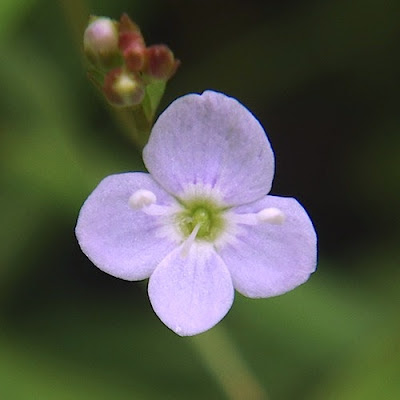.jpg) |
| Flower of an unnamed native buttercup, photographed with my old Spotmatic. The flower is probably about 15 mm diameter. |
Digital cameras are evolving rapidly and so I seem to need a replacement every few years. Fortunately they're also getting cheaper as they get better. I'm reluctant to shell out a lot of money for a digital SLR, knowing in a few years it'll be obsolete, or at least surpassed by newer models. However, I would like to get closer to small flowers, so I've been playing with cheap alternatives.
The latest is a $10 home-made macro lens. It's inspired by the idea of the Ōlloclip lenses for iPhone (I've just bought a set of these and they're pretty good and very portable). You can get reasonable results by simply holding a botanist's field lens in front of the camera lens, but I was lucky enough to have a cheap jeweler's loop that fits quite snugly over the lens of my camera. Unfortunately though, it's a bit tricky to hold it aligned in place while you take the photo. I wanted something a bit more stable.
I hit on the idea of using cheap plastic plumbing attachments to hold the lenses together. Here's the camera with the parts of the new system. The loop fits snugly in one end, and the other end fits snugly over the camera lens when it's extended. You have to zoom a bit to fill the field of view.
 |
| My point & shoot camera with components of the clip-on macro lens: a $2.50 plastic pipe attachment and a $10 jeweler's loop. |
 |
| The macro lens clip-on in place. |
The new system has quite a good working distance and is easy to use. There is a little distortion of parallel lines (see above), and there might be other effects like chromatic aberration that I haven't looked for. But at $12.50, it's a bargain. I'm playing with other improvised systems too, and might report on them later.
I used it in the field this week too:
 |
| Veronica scutellata, Foxton Beach. In the original photo, the flower was 1240 pixels across; in life it's about 6mm. |
 |
| Veronica catenata, Himitangi Beach. In the original photo, the flower was 800 pixels across; in life it's about 4 mm. |
To finish, here's what the Ōlloclip macro lens can do with an iPhone 4S:
 |
| Veronica serpyllifolia capsule. It's 4 mm across, and spans about 600 pixels in the original. |
It focuses at 13mm, so I guess I need some kind of adjustable stand to hold the phone at that distance from the subject. I've started building one.

This comment has been removed by a blog administrator.
ReplyDeleteThis comment has been removed by a blog administrator.
ReplyDeleteThis comment has been removed by a blog administrator.
ReplyDelete